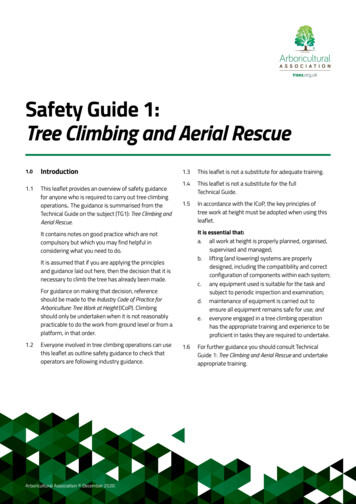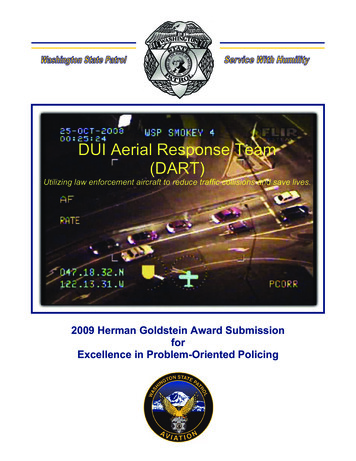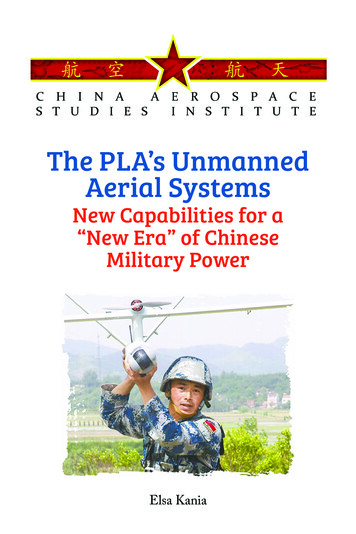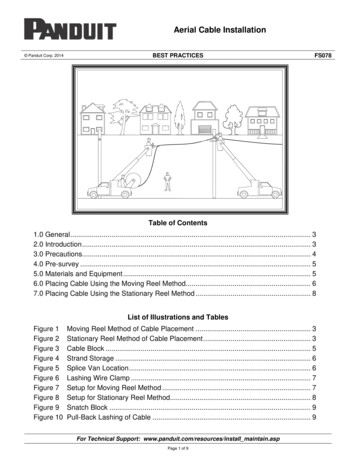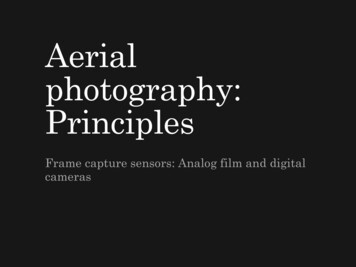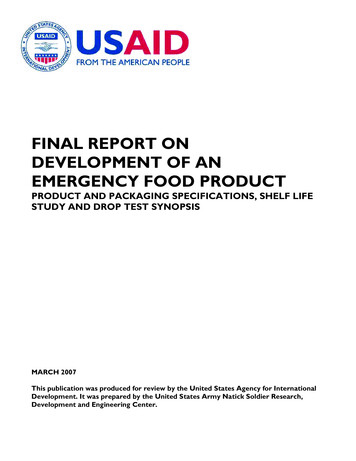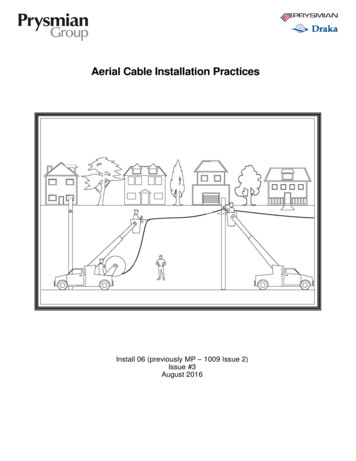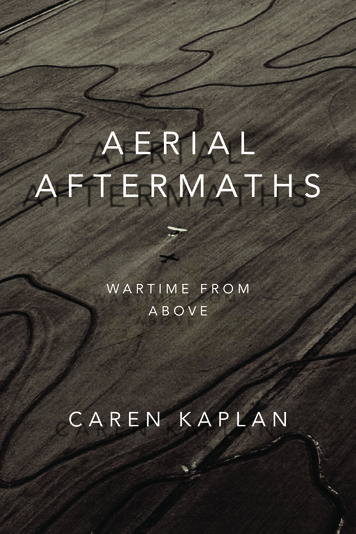
Transcription
AERIALA F T EAREMATHSRIALA F T E R M AT H SWARTIME FROMABOVEWARTIME FROMABOVECAREN KAPLANCAREN KAPLAN
AERIALA F T E R M AT H Snext wave: new directions in w omen ’ s studies—Caren Kaplan, Inderpal Grewal, Robyn Wiegman, Series Editors
AERIALA F T E R M AT H Swa r t i m e f r o m a b o v eCAREN KAPLANDuke University PressDurham and London2018
2018 Duke University PressAll rights reservedPrinted in the United States of Amer ic a on acid- free paper Designed by Heather HensleyTypeset in Minion Pro by Westchester Publishing ServicesLibrary of Congress Cataloging- in- Publication DataNames: Kaplan, Caren, [date–] author.Title: Aerial aftermaths : war time from above / Caren Kaplan.Description: Durham : Duke University Press, 2017. Series: Next wave Includes bibliographical references and index.Identifiers: lccn 2017028530 (print) lccn 2017041830 (ebook)isbn 9780822372219 (ebook)isbn 9780822370086 (hardcover : alk. paper)isbn 9780822370178 (pbk. : alk. paper)Subjects: lcsh: Photographic surveying— History. Aerial photography— History. War photography— History. Photography, Military.Classification: lcc ta593.2 (ebook) lcc ta593.2 .k375 2017 (print) ddc 358.4/54— dc23lc rec ord available at https:// lccn . loc . gov / 2017028530Duke University Press gratefully acknowledges the support ofthe University of California, Davis, which provided funds tosupport the publication of this book.Cover art: Grant Heilman PhotographyFrontispiece: Thomas Baldwin, “The Balloon Prospect fromabove the Clouds,” in Airopaidia. Hand- colored e tching.Yale Center for British Art, Paul Mellon Collection.
For Sofia—
CONTENTSacknowl e d gments i xIntroductionAERIAL AFTERMATHS 11. Surveying War time AftermathsTHE FIRST MILITARY SURVEY OF SCOTLAND 342. Balloon GeographyTHE EMOTION OF MOTION INAEROSTATIC WAR T IME 683. La Nature à Coup d’Oeil“SEEING ALL” IN EARLY PA N ORAMAS 1044. Mapping “Mesopotamia”AERIAL PHOTOGRAPHY INEARLY TWENTIETH- C ENTURY IRAQ 1385. The Politics of the SensibleAERIAL PHOTOGRAPHY’SWAR T IME AFTERMATHS 180AfterwordSENSING DISTANCE 207notes 2 17 works cited 255 index 277
A C K N O W L E D G M E N T SWhen did this book begin? Watching the “tele vi sion war” in Indochina unfold when I was young? Looking on as the new twenty- four- hour cable newsstations helped to produce the my thol ogy of precision warfare by transmitting “smart bomb” footage during the First Persian Gulf War? Answering thephone on the morning of September 11, 2001, when my friend Jenny calledto tell me to “turn on the tele vi sion”? Feeding my infant daughter with oneeye on the news as the “shock and awe” invasion of Iraq took place in 2003? These mediated experiences have led me to won der what happens to a society that proposes a war with largely hidden costs and damages to t hose whowage it. Losing the ability to understand the costs of war at a distance leadsto a similar loss of recognition of conflict and vio lence “at home.” Although people in the United States “see” more than ever thanks to conventional andsocial media linked to the proliferation of communicative devices and networks, we do not always see clearly what we have lost or sense what remainsimperceptible. This book emerged over a long period of time as I ponderedthe unseen as well as the seen, the ways in which spatial and temporal dis eople, places, and things sharply vis i ble as targets whiletance render some pmissing entirely other worlds of pos si ble affiliation and recognition. There were many people who assisted and inspired me in the pro cess of turningthis inquiry into a book. Fasten your seat belt (or skip what comes next ifyou are impatient) because I have a lot of people to thank.I must begin with the p eople I never tire of talking to no m atter howmany years or miles intervene between our meeting in person. InderpalGrewal, Minoo Moallem, and Jennifer Terry are the best friends of a lifetime of
thinking, writing, teaching, and fighting the endless good fight at our workplaces. There are really no adequate words to thank them for the constancyof their friendship and the inspiration I derive from their scholarship. Justacross the street from my h ouse I discovered a brilliant interlocutor andfriend; Marisol de la Cadena has handed me just the right book to throwme into a tizzy of new thoughts, dropped just the right comment when Ihave been stuck, walked miles with me when I have felt too sedentary, andpoured me innumerable glasses of wine when work needed to stop for theday— thank you, neighbor. Lisa Parks has boosted my morale, inspired mewith her tour de force scholarship, and demonstrated to me once again thatcollaboration can be one of life’s joys. I share house holding, parenting, andacademic life and so much more with Eric Smoodin; I could write an entirebook singing his virtues and never get to the end— absolutely nothing happens in my life without his loving care and support and I am so deeplygrateful. Fortunately, I think that he has gotten over his shock when I firstasked him if he happened to have a dvd copy of Test Pi lot. Reader, he did.The greatest joy in working on an other wise sad topic has to be the circleof smart, supportive companions who inspire and join in the work. Deborah Cowen and Emily Gilbert, you are my heroes forever. Javier A rbona,Simone Browne, Lisa Cartwright, Deborah Cohler, Carolyn Dinshaw, Vernadette Gonzalez, Juana María Rodriguez, Laura Kurgan, L éopold Lambert, Marget Long, Chandra Mukerji, Anjali Nath, Mimi Nguyen, SimaShakhsari, Ella Shohat, Mimi Sheller, Bob Stam, Lucy Suchman, FedericaTimeto, Robyn Wiegman, and Barb Voss lift my spirits with their innovative, interdisciplinary scholarship and personal generosity. Manythanks to Peter Adey, Attiya Ahmad, Paul Amar, John Armitage, AaronBelkin, Ryan Bishop, Leigh Campoamor, Jordan Crandall, Tim Cresswell,Rosita Dimova, Ricardo Dominguez, Melinda Fagan, Keith Feldman, ElenaGlasberg, David Theo Goldberg, Gaston Gordillo, Stephen Graham, SarahGreen, Derek Gregory, Stephen Groening, Roger Hallas, Jennifer Hamilton, Ömür Harmanşah, Cory Hayden, Jake Kosek, Mary Lou Lobsinger, ubin, Derek McCormack, Nick Mirzoeff, Chandra Mukerji, SorayaAlex LMurray, Catherine Sameh, Chris Schaberg, David Serlin, Yuan Shu, CharlesStankevich, Jonathan Sterne, Phillip Vannini, Jutta Weber, Laura Wexler, and Su- lin Yu for inviting me to t hings, reading things, publishing things— making all the impor tant things pos si ble including drinking andeating in such good com pany. Th ere are so many p eople who have takenan interest, cheered me on, passed along an idea or source, or served asrole models and stellar colleagues; among them, thank you Crystal Baik,xAcknowl e dgments
Tani Barlow, Lauren Berlant, Sutapa Biswas, Judith Butler, Rey Chow, JimClifford, Cathy Davidson, Joe De Lappe, Lindsey Dillon, Fran Dyson,Anna Everett, Bia Gayatto, Bill Germano, Ruth Wilson Gilmore, JenniferGreenburg, Anitra Grisales, Akhil Gupta, Yannis Hamilakis, Donna Haraway, Waleed Hazbun, Brett Holman, Lochlann Jain, Miranda Joseph,Doug Kahn, Laleh Kalili, Ronak Kapadia, Amy Kaplan, Jim Ketchum, JillLewis, Jon Lewis, P eter Limbrick, Catherine Lutz, Karim Makdisi, PurnimaMankekar, Franco Marineo, Donald Moore, Ruth Mostern, Jen Southern,Rebecca Stein, Hayden White, and Jayne Wilkinson. Paul Saint- Amourkindly shared images with me at a key juncture. A special thanks to RebeccaWexler for generously sharing her wonderful master’s thesis research withme. I am deeply grateful to Jananne al- Ani, Sophie Ristelhueber, and FazalSheikh for giving me permission to include their art work in this book.Some of my research and writing was greatly aided by a Digital Innovation Fellowship from the American Council of Learned Socie ties and auc President’s Faculty Research in the Humanities Fellowship as well as auc Davis Humanities Institute Faculty Research Seminar Grant. The ucHumanities Research Institute (uchri) has provided me with funds for working groups, conferences, and many workshops at uc Irvine, uc Berkeley, anduc Davis— I am so grateful to David Theo Goldberg and the wonderful staff atuchri. I thank former uc Davis Humanities, Arts, and Cultural Studies DeanJessie Ann Owens as well as interim deans Pat Turner and Susan Kaiser fortheir support of my research over the years. Some of my work has receivedsupport from the uc Davis Office of the Vice Chancellor for Research and theCenter for Women and Research. A residency fellowship from the Universityof Southern California led me to work with the amazing Tara McPherson andthe entire talented editorial and design group at Vectors: Journal of Culture andTechnology in a Dynamic Vernacular— Steve Anderson, Erik Loyer, RaeganKelly, and Craig Dietrich. Working with Erik Loyer on the ACLS multi- mediaproj ect Precision Targets helped me to develop and realize my ideas in waysthat continue to unfold.What would I have done without my wonderful online writing partners on Alan Klima’s Academic Muse website— most of them anonymousbut nonetheless dear to me— and on the l ittle Facebook “Writing Everyday”group started by Toby Beauchamp that grew and grew? You all kept me sane,helped me adhere to deadlines unrealistic and dire. You taught this rather oldacademic plenty of new tricks. And, we continue! In par tic u lar, all my gratefullove goes to four nonanonymous, brave, and brilliant writing pals who arealways t here with me: Susana Loza, Juana María Rodriguez, Sue Schweik,Acknowl e dgments xi
and Barb Voss. Thank you, Eric Smoodin, for writing with me e very day andreading every thing many, many times over with patient care.Working in the acad emy for so many years, I have had the im mense plea sure of working with extraordinary students who have become colleagues or people in the world d oing significant work. I have learned so much from eachof them, including Rusty Bartels, Toby Beauchamp, Tallie ben Daniel, HilaryBerwick, Abigail Boggs, Rebecca Carpenter, Mark Chiang, Ben D’Harlingue,Rebecca Dolhinow, Candace Fujikane, Jane Garrity, Kristen Ghodsee, Vernadette Gonzalez, Ju Hui Judy Han, Mayu Haldan Jones, Gillian Harkins, HsuanHsu, Gretchen Jones, Tristan Josephson, Kim Kono, Karen Leong, SusanaLoza, Victor Roman Mendoza, David Michalski, Elizabeth Montegary, JamilaMoore- Pewu, Josef Nguyen, Mimi Nguyen, Nancy Ordover, Jackie Orr, Christina Owens, Terry Park, Katrina Petersen, Jami Proctor- Xu, Jasbir Puar, JillianSandell, Millie Thayer, Kara Thompson, Barb Voss, and Edlie Wong. It hasbeen my joy to help to build and maintain the cultural studies PhD programat uc Davis and I want to send a shout- out not only to recent gradu ates, someof whom are mentioned above, but also to current students, especially XanChacko, Diana Pardo Pedrazo, Andrea Miller, Toby Smith, and May Ee Wong.My colleagues in the Department of American Studies at uc Davishave supported me e very step of the way; my deepest thanks to my current chair, Julie Sze, and to Javier Arbona, Charlotte Biltekoff, Ryan LeeCartwright, A njali Nath, Michael Smith, Eric Smoodin, Carolyn Thomas,and Grace Wang. Some colleagues extend themselves to truly remarkabledegrees. Thanks to Christina Cogdell’s incredible generosity I was able tospend three weeks in London to do primary research at a key point in mywork. Thank you, Christina, from the bottom of my heart for the airlinemiles, drinks at the pub, the fun exploring, the couch to sleep on, and wonderful conversation. My work has been enlightened by hours of conversation with colleagues and gradu ate students in our research group on criticalmilitarization, policing, and security studies (with special thanks to JavierArbona, Lindsey Dillon, and Anjali Nath). The vibrant sts community(and the ModLab crew) at uc Davis has offered me intellectual stimulation and collegial opportunities galore; it is a plea sure to work with MarioBiagioli, Patrick Carroll, Tim Choy, Marisol de la Cadena, Joe Dumit, JimGriesemer, Tim Lenoir, Emily Merchant, Colin Milburn, Roberta Milstein,and Kriss Ravetto- Biagioli. Colleagues from other programs with whom Ishare work and to whom I owe many thanks and collegial recognition include Larry Bogad, Angie Chabram, Seeta Chaganti, Elizabeth Constable,Maxine Craig, Roberto Delgadillo, Tarek El Haik, Omnia El Shakry, KrisxiiAcknowl e dgments
Fallon, Margie Ferguson, Jaimey Fisher, Kathleen Frederickson, Beth Freeman, Laura Grindstaff, Luis Guarnizo, Angela Harris, Wendy Ho, RobertIrwin, Suad Joseph, Molly McCarthy, Sunaina Maira, Desiree Martin, JohnMarx, Liz Miller, Flagg Miller, Susette Min, Fiamma Montezemolo, BettinaNg’weno, Kimberly Nettles, Hearne Pardee, Robyn Rodriguez, Parama Roy,Suzana Sawyer, Sudipta Sen, Maurice Stierl, and Gina Werfel. Susan Kaiserhas extended many kinds of thoughtful support— from my hire years ago toall her current support of the faculty as our interim dean. Among the manycurrent and former staff people who have kept my world running, I wouldlike to thank in par tic u lar Naomi Ambriz, Aklil Bekele, Lisa Blackford, Anthony Drown, Evelyn Farias, Carlos Garcia, Fatima Garcia, Maria Garcia,Stella Mancillas, Omar Mojaddedi, Melanie Norris, and Tina Tansey. I havealso benefited so much from the hard work of a series of gradu ate studentresearch assistants over the years; for this book in par tic u lar I would like tothank Cathy Hannabach and Myrtie Williams and, for rather extraordinarydedication at the bitter end, the very wonderful Andrea Miller.To my friends and family far and wide who support me through thickand thin, cook dinner, buy drinks, like my social media posts (or not, butlove me anyway), and sustain me always— thank you, Deborah Agre, RosioAlvarez, Arash Bayatmakou, Shahin Bayatmakou, Randy Becker, AmyBomse, Michael Brondoli, Steve Boucher, Sharon Butler, Fred Davidson,Coca Eckel, Lena Flaum, Henry Flax, Mitch Flax, Al Jessel, Kirin Jessel,Sonal Jessel, Surina Kahn, Heidi Kaplan, Mitch Kaplan, Martha Lewis,Monica McCormick, Ann Martin, David Norton, Bob Reynolds, BritaSands, Naomi Schneider, Robbie Smoodin, Carolyn Thomas, Bharat Trehan, Anna Weidman, and Emily Young. My loving thanks for the “eggs”to my beloved friends from college days: Meredith Miller, Ruth Rohde,Sig Roos, and Diana Stetson. Margie Cohen, Renee Dryfoos, Sarah Gould,and Rebecca Pope have brought me through it all not too much the worsefor wear and much healthier in body and mind. The truism that “it takes avillage” is never truer than when you are an older parent without any relatives living nearby. Thank you, Leslie Blevins, David de la Peña, NatalyaEagan- Rosenberg, Artur Janc, Kasia Koscielska, Travis Milner, FernandoMoreno, Paul Moylan, Matt Rosenberg, Carolyn Thomas, Valerie Venghiattis, and Jennie Wadlin- Moylan for all the shared childcare and goodcom pany over the years when I was writing this book.Years ago, in a snowstorm, I talked for hours with a fascinating personwho became my editor and dear friend. Thank you, Ken Wissoker, for allyour advice and generous support. The entire team at Duke University PressAcknowl e dgments xiii
has taken great care with this book proj ect. Thank you, especially, ElizabethAult. I am also most grateful to the anonymous readers who gave me insightful and constructive suggestions for revision.This book was written during a time in my life of tremendous loss.Mourning has brought me closer to the subject of my work in ways I couldnever have predicted. First, I must remember the first professor who tookme seriously, Lester Mazor. I miss his wry sense of humor and his brilliantmind. His steady friendship expressed itself over de cades of lively lettersexchanged and occasional, jovial meals enjoyed together. Michael Ragussisshowed me that a se nior colleague can become a best friend. His wit, erudition, and unending generosity filled my life with encouragement and joy. Icannot believe he is really gone and I miss him more than I can say. AlanPred opened up the field of geography to me by inviting me to every thingwith great enthusiasm and kindness. He got me into all kinds of trou ble andI loved him for it. Fi nally, but most importantly, I thank my parents for theirnever- ending faith in me and for the gift of their close presence in their lastyears. Arthur Kaplan and Doris Flax Kaplan loved books, gardens, food,beauty in form and function, and their c hildren, grand child, relatives, andfriends. They wanted me to finish this book; they willed it in many wayseven as my grief in losing them also required more time and thought thanI might have imagined. I kept their memory close to me as I completed thiswork and I will have to be content with that as I celebrate its closure.This book is dedicated fully and with all my heart to my daughter, SofiaMalka Smoodin- Kaplan. Sofia, thank you for holding just the right amountof curiosity in and distance from this work I have been d oing throughoutthe span of your life thus far. Thank you for helping me step away and forsharing me when I have needed to step back in. You learned to spot “aerialperspective” in a movie almost as soon as you learned to speak and youcheerfully lugged packages into my study with just the right touch of fondsarcasm to announce “Surprise, it’s another book!” So, here is another book.This one is for you.xivAcknowl e dgments
INTRODUCTIONAerial Aftermaths— A new visual culture redefines both what it is to see, and what thereis to see.— B RUNO LATOUR , “Drawing Things Together”The world is a mobile texture of these distinctions between seen andseeing objects. It is the stuff in which the inner folding, unfolding andrefolding takes place which makes vision pos si ble between things.— M ICHEL DE CERTEAU , The Practice of Everyday LifeMore than a de cade after the collapse of the World Trade Center towers, onecan get a shiver down one’s spine reading the first line of Michel de Certeau’siconic chapter “Walking in the City” in The Practice of Everyday Life: “SeeingManhattan from the 110th floor of the World Trade Center” (de Certeau 1984,91). These twin towering structures signified both the glamor and the rapacious global reach of the metropolis whose southern endpoint they anchoredas well as the strug gle for the soul of neighborhoods in the midst of rampantgentrification.1 In a city of many “sights,” the towers were themselves objectsto be seen, their distinctive silhouettes readily identifiable in the skyline oftheir era. The towers also offered spectacular views— unobstructed sightlines from the South Tower’s observation deck could stretch to fifty miles ona clear day. Observing New York City far below from a platform over 1,300feet in the air induced in de Certeau a “voluptuous plea sure” in “seeing the whole,” to read the city from a distance like a “solar Eye,” “looking down likea god.” This textualization of the g reat metropolis through aerial viewing
convinced de Certeau that New York, unlike its more ancient Eu ro peancounter parts, continually “invents itself,” showing l ittle regard for the pastor the f uture. From the 110th floor, he wrote, the pres ent is perceptible asexcessive energy, a “universe that is constantly exploding.” On an early autumn day in 2001, spectators looked up at the World Trade Center towersas the past and the f uture converged on the pres ent. The view from thetowers themselves in their last hours is not one we want to invite into ourminds. Years later, far into the “war on terror” that permeates the aftermathof this event, rereading de Certeau’s writing on aerial views, the towers thatbecame tropes of po liti cal extremism of all kinds return to their earlierstatus not only as the nth degree of muscular urban architecture but as platforms for a specific kind of observation and practice of perception— distant,remote, abstract. Their apocalyptic fate hovers around de Certeau’s musingon the disembodied effect of being lifted so high into the air— a weightlessness, he argues, that dissolves the spectator into a reader of a spectacularview “and nothing more” (92).That view from an observation deck that now no longer exists promptedde Certeau to contrast aerial observers to the city’s walkers, who “operatebelow the thresholds at which visibility begins,” making use of “spaces thatcannot be seen” (93). De Certeau’s walkers “write” the urban space ratherthan panoptically “read it”; “neither author nor spectator,” the city’s walkers resist repre sen ta tion to make city life through everyday movement. Ade cade and a half a fter the towers collapsed, a fter the war on terror andits tributary vio lence and security practices have convinced many of usthat nothing remains potentially “unseen,” de Certeau’s poetic conceptionof an embodied network of “moving, inspecting writings” that “compose amanifold story” of everyday life that evades the “planned and readable city”through an “opaque and blind mobility” could suggest a romantic fantasy(93). In this opposition between power ful panopticism and subterraneanre sis tance, which is as old as modernity, at least, aerial views play a villainous role. Seductively pleas ur able and all- empowering, the view from abovepromises to reveal all to the state or to any other entity that can mobilizethe resources to produce these kinds of images. Against the totalizing viewthat produces repre sen ta tion, unruly and random mobile networks keepmoving, evading the search beams of the God’s eye, building meaningfulplaces through layers of memories stitched together by embodied quotidian practices. This book argues that the history of aerial views— whetherobserved from towers or mountains or hot air balloons or planes, whetherincorporated into cartographic surveys or panoramic paintings— trou bles2Introduction
this conventional divide between power and re sis tance in the storyline of visual culture in modernity. I would suggest that we move beyond de Certeau’sevocative opposition between “seen and seeing objects” to consider the pos si ble presence of the unseen or unsensed, not to resort to identification orto construct a romanticized alterity but to let go of the desire for totalizedvision that requires a singular world, always already legible, along with itsoppositional counterpart. If the cultural history of aerial views conveys anylesson at all, it may be the recognition of the vio lence always already inherent in pursuing both desires.SPECTACUL AR AFTERM ATHWe have seen the Twin Towers collapse hundreds of times on TV. The steel andglass skyscrapers exploding like a bag of flour, the dust and smoke pluming outacross Manhattan. But never like this, from above.— Philip Delves Broughton, “Dramatic Images of the World Trade CenterCollapse”In February 2010 a “trove” of aerial photo graphs of the collapsing WorldTrade Center towers was broadcast on abc tele vi sion news and circulatedwidely online (see plate 1). These previously “unseen” images, according toan Associated Press (ap) report, offered “a rare and chilling view from theheavens of the burning twin towers and the apocalyptic shroud of smokeand dust that settled over the city.” The photo graphs, taken on the morningof September 11, 2001, by Greg Semendinger, a New York Police Department(nypd) aviation unit he li cop ter pi lot, had been sitting in an archive maintained by the National Institute of Standards and Technology (nist), thefederal agency that was put in charge of the investigation of the twin towers’ collapse. After abc News filed a Freedom of Information Act request,2,779 photo graphs (including Semendinger’s) stored at nist on nine compact discs were released, and a small number of Semendinger/nist images were disseminated to the public in two batches. In the parroting nature ofcon temporary news culture, all subsequent stories about the distributionof the Semendinger/nist aerial images pushed the same a ngle— the nypdhe li cop ter contained the “only photog raphers allowed in the airspace nearthe skyscrapers on Sept. 11, 2001”— with the accompanying headlines: “9/11photos show day from dif fer ent perspective” and “8 years l ater, the picturesstill shock” (Ilnytzky and Long 2010, 2).Aerial observation is reputed to offer a field of vision radically dif fer entfrom the point of view that is available from the ground. Si mul ta neouslyIntroduction 3
perceived to be abstract and realistic, once channeled into a medium like asketch, painting, or photo graph, the “view from above” invites decipherment.Usually associated with utilitarian state, military, or municipal proj ects (reconnaissance, surveying, cartography, urban planning) or modernist aesthetics(abstraction, minimalism, objectivism) or a specific genre of con temporarynarrative landscape photography, aerial imagery is inevitably tied, historically and technologically, to modes of passive and powered aviation as wellas methods of mechanical production and reproduction that structure thepossibilities and constraints of the imagery. Due to the flattening effect onperception of three- dimensional objects generated by extreme height, mostmilitary aerial reconnaissance photography has been believed to be usefulonly to specialized analysts in time of declared war or to be of historicalvalue solely to scholars or “niche” art collectors (Sekula [1975] 1984, 33). Yetthis very quality of the aerial image can generate dynamic interest as theviewer attempts to “see” clearly what appears at first glance to be “unseeable.”The history of aerial imagery itself reveals the emergence of “ways of seeing”that underscore the uneven and varied nature of embodied observation inmodernity, as well as the instability of vision’s primacy in Western culture(Berger 1972, 7; Jay 1994).The first eyewitness accounts of the view from above generated by the advent of human flight did shock and fascinate as they circulated in late eighteenth- and early nineteenth- century public culture. Emerging in an era ofnear- constant revolution and warfare, “prospects” sketched from balloons andthe elevated perspectives exhibited in panoramic rotundas joined bird’s- eyeviews, war maps, and estate surveys to entertain as well as to inform. This earlyversion of what James Der Derian (2001) now calls the “military- industrial- media- entertainment network” gathered together the latest scientific inquiriesinto optics and chemistry with developments in landscape art and surveying practices along with emergent culture industries to bring war time intoeveryday life, representing war at a distance in contrast to thriving Eu ro peanmetropoles “at peace.” Paul Virilio has argued that the power ful combinationof the airplane and the practice of photography in the early twentieth centuryinaugurated new intensities in this historical evolution of visual culture,bringing the mode of warfare observation into perception itself (1989, 19). Perception, however, is not a stable thing, and neither is warfare. Both humanflight and photography along with cartography made pos si ble new dynamicinterplays between “seen” and “unseen” ele ments, establishing the ambiguitiesof aerial observation while intensifying the links between these practices andthe waging of war.4Introduction
FIGURE I.1 Pre- attack mosaic view of Hiroshima, Japan, April 13, 1945. U.S. WarDepartment.Perhaps due to the inherently ambiguous nature of aerial imagery and itsmostly ephemeral, utilitarian function in military practice, only a few viewsfrom above hold iconic status in the public rec ord of catastrophic and violent events. Thus, Davide Deriu has argued that while many genres of photography have been linked to memorialization following traumatic, violentevents, aerial photography has usually been excluded (2007, 197). Perhapsit would be more accurate to say that public disclosure of aerial imagerypostattack or after a catastrophic event is a more recent phenomenon linkedto increasingly globalized media industries and the availability of multiplysourced imagery.2 Until the coincidence of the ramp-up of visual technologies that became associated with the war on terror a fter 9/11 and the adventof social networking with its intensely rapid circulation of digital imagery,3along with the unquenchable thirst of news outlets for information producttwenty- four hours a day, the “God’s- eye view” of violent scenes was e itherclassified as “secret” by the military or released on an extremely selective basis (for example, high- altitude reconnaissance images of Hiroshima “before” and “ after” the U.S. attack by atomic bomb) (see figs. I.1 and I.2).For most of the twentieth c entury, aerial photography of traumatic or violent events was usually associated with official surveying, documenting, andconducting of surveillance and reconnaissance rather than the capturingof images at the “ human” level of individualized suffering that is usually associated affirmatively with photojournalism. T oday, any major event is accompanied by aerial imagery that displays the size of the demonstration, forexample, or a satellite image of the location of interest.4 Ubiquitous aerialIntroduction 5
FIGURE I.2 Post- attack mosaic view of Hiroshima, Japan, August 11, 1945. U.S. WarDepartment.imagery now saturates global media as well as social networking practices,reworking the distinction between distance and proximity in reporting thescale of violent or significant events.Arguably, at the cusp of the turn of this c entury, that structuring distinction between remote documentation and humanist portraiture still heldfirm. There are numerous examples of ground- level photojournalism in the9/11 visual archive.5 For example, around the time of the fifth- year commemoration of the attacks in New York, two collections of photo graphs taken byphotog raphers on the ground were published, both titled Aftermath. In Af termath: Unseen 9
uc Davis Humanities Institute Faculty Research Seminar Grant. The uc Humanities Research Institute ( uchri) has provided me with funds for work-ing groups, conferences, and many workshops at uc Irvine, Berkeley, and uc Davis— am so grateful to David Theo Goldberg and the wonderful staff at I uchri.
